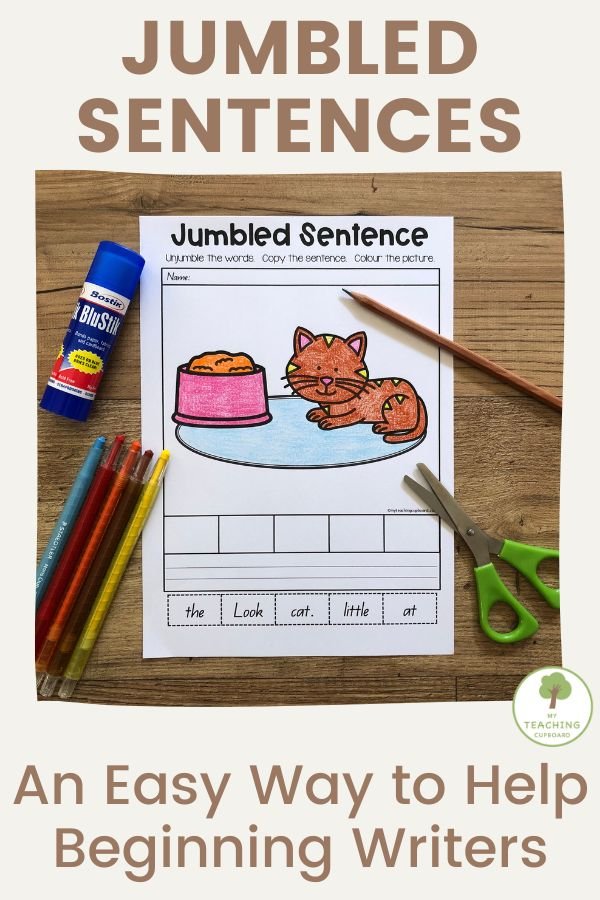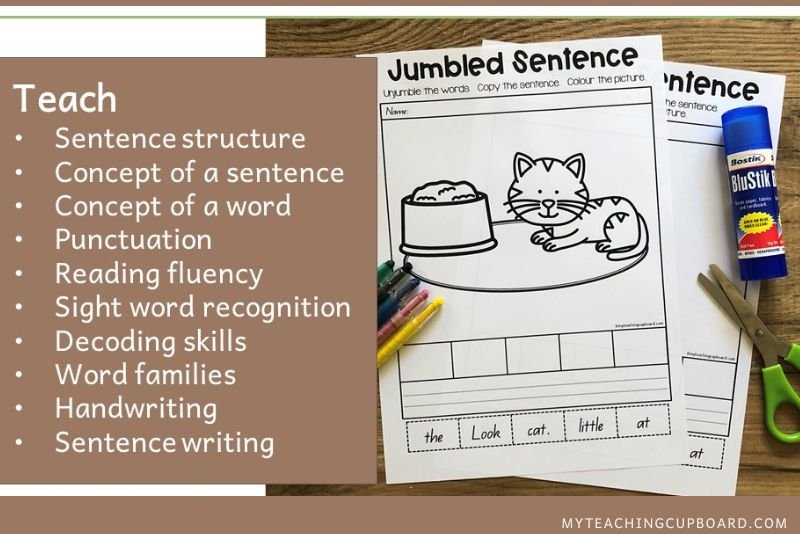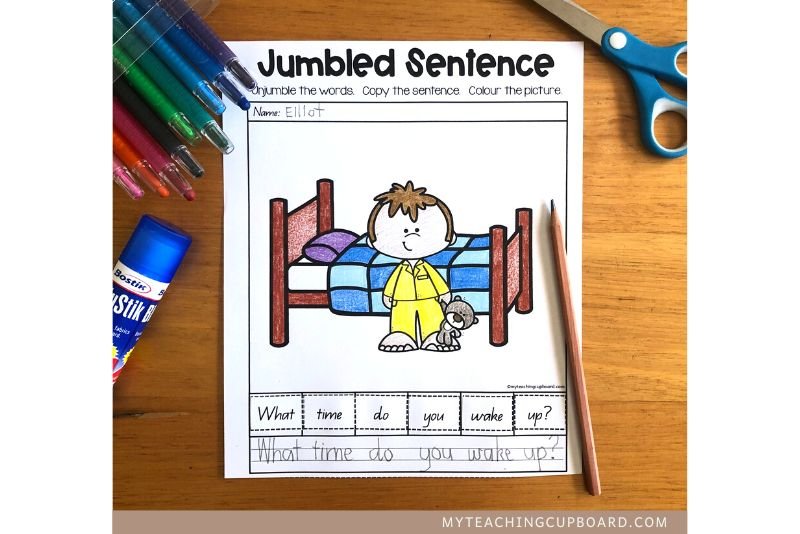Jumbled Up Sentences - An Easy Way to Help Beginning Writers
Jumbled-up sentences might appear to be a simple activity, but their potential to enhance writing skills in beginning writers is underrated. As teachers working with young children in kindergarten and grade one, we're always on the hunt for effective literacy activities. Whether you're a play-based educator or not, jumbled sentences offer something for every educator teaching literacy to young children.
Don’t use this engaging reading and writing activity as just a time filler in your literacy block. It’s a meaningful exercise supported by the Science of Reading research.
Read on to discover what they are and how you can use them in your classroom to boost literacy skills.
What is a Jumbled-up Sentence?
A jumbled-up sentence is a set of words that are mixed up and need to be rearranged into a proper sequence in order to make a complete, meaningful sentence. For instance, take the words run, can, I and fast. The correct order in a sentence would be I can run fast.
In early years classrooms, the activity of arranging jumbled sentences into the correct order may be referred to by many different names or terms. Here are some of the terms you might hear teachers using:
Scrambled Sentences
Mixed-Up Sentences
Sentence Sorting
Word Order Practice
Sentence Reconstruction
A scrambled sentence or a jumbled sentence (as I like to call them) is a type of sentence puzzle that makes children think and use their literacy problem-solving skills. It is a sentence that has the words in the wrong order, meaning it doesn't make sense. The task is for children to reorder the sentence so it reads correctly and has meaning.
What are the Learning Objectives of Jumbled Sentences?
The learning objectives align well with ACARA English learning intentions. Jumbled sentences focus on:
Understanding the basic order of the words in a sentence.
Enhancing writing skills.
Engaging in sentence structure practice.
These activities can serve as engaging ways to practice syntax, sentence structure, and grammar basics in a playful yet educational way.
A typical example of a learning objectives you might see in a teacher’s literacy planning is:
Objectives: Students will gain practice reading and recognising words by re-creating sentences with 100 percent accuracy. Students will gain knowledge about sentence structure by putting words into the correct grammatical order with 90 percent accuracy.
Jumbled sentences will help your students build sentences and improve their writing. As children learn to unjumble the words to make a proper sentence, they will learn about punctuation too. Students will quickly see the first word in every sentence starts with a capital letter, and the last word is followed by a full stop.
Reading and writing accuracy will also be improved when children work on unjumbling sentences. The whole aim of the exercise is to create a sentence that makes sense.
Basic reading and decoding skills will also be developed because students will need to read the words over and over as they work out the correct word order for the sentence.
Teachers in kindergarten often use jumbled sentences as an educational activity to help children develop their language and literacy skills. They are a common activity in my literacy rotations. Here are a few common reasons why we might use jumbled sentences:
Sentence Structure: Jumbled sentences allow children to practice and understand the structure of sentences, including the placement of nouns, verbs, adjectives, and other parts of speech. By rearranging the words and phrases, children learn how to construct grammatically correct sentences.
Vocabulary Development: Jumbled sentences provide an opportunity for children to expand their vocabulary. As they work on unscrambling the words and forming correct sentences, they encounter new words and learn their meanings in context.
Reading Comprehension: Jumbled sentences can improve a child's reading comprehension skills. In fact, jumbled sentences are a common reading activity in most early years classrooms. By rearranging the words, children need to read and understand the meaning of each word in order to reconstruct the sentence correctly. This activity helps students to develop their ability to comprehend written text.
Problem-Solving and Critical Thinking: Jumbled sentences encourage problem-solving and critical thinking skills. Children need to analyse the words, their meanings, and the context to figure out the correct order and form a meaningful sentence. This activity enhances their logical reasoning and cognitive abilities.
Language Fluency: Jumbled sentences can aid in developing language fluency. Students will practice forming sentences quickly and accurately in this activity. This is going to help them improve their overall fluency in speaking and writing too.
Fun and Engagement: Jumbled sentences provide an interactive and enjoyable learning experience for young children. My students love the challenge of a jumbled sentence and feel so proud of themselves when they finish the task. This activity adds an element of challenge and excitement to our literacy block.
Overall, jumbled sentences are a valuable teaching tool in kindergarten and grade one classrooms as they promote language development, vocabulary expansion, reading comprehension, problem-solving skills, and fluency, all while being a fun and interactive activity for the children.
But don’t just take my word for it. Read on to discover what some of the Science of Reading Research can tell us about the effectiveness of jumbled sentences in literacy instruction.
Science of Reading Research on Jumbled Sentences
When it comes to teaching kids to read, research is important. The Science of Reading Research is invaluable for providing us with teaching strategies that have been proven to work. One such strategy? Jumbled sentences.
A recent study Teaching Reading Using Jumbled Sentences, by Ria Sakia and Ulsy Kulsum Marantika, offers valuable insights into the effectiveness of using jumbled sentences in educational settings.
The study concluded that implementing jumbled sentences significantly improved students' reading abilities. Not only did this teaching technique make it easier for students to clarify their thoughts prior to drafting, but it also encouraged them to develop and connect ideas stored in their cognitive schema. This positive impact was quantitatively supported: students' mean reading scores rose from 50.34 in the pretest to 78.45 in the posttest, a change statistically significant at a value less than 0.05.
Overall, students reported feeling happy, engaged, and interested when learning to read using jumbled sentences. Consequently, the study affirms that jumbled sentences are an effective and enjoyable technique for teaching reading skills.
Using jumbled sentences in your literacy instruction is not only about keeping your kids engaged. It's about effective teaching that leads to real learning gains. Your literacy instruction should always be backed by solid research because when it comes to teaching kids to read and write, I’m sure you’ll agree - there's no room for guesswork!
If you are interested in The Science of Reading Research, you can read more about it at Australia’s national education evidence body – The Australian Educational Research Organisation. They have heaps of information on the science of reading.
How to Use Jumbled Sentence Worksheets in the Classroom
Jumbled sentence worksheets are incredibly versatile and can be easily used in a variety of literacy settings.
At a literacy center, they serve as an excellent tool for small-group collaboration, allowing children to work together to solve the scrambled sentence puzzles. To develop oral language communication skills, social skills and teamwork, I like my children to work with a friend whenever possible.
As an independent literacy activity, jumbled sentences are the perfect self-paced learning activity. Once students are familiar with the task, they require minimal guidance from the teacher. An independent activity like this will allow you to focus on your explicit teaching groups during literacy rotations.
The true beauty of these worksheets is their adaptability; they transition easily from classroom to home. If you are required to assign homework like we are, jumbled sentence worksheets can be an easy but meaningful homework task. Students can take the sheet home, rearrange the sentences, and return it the next day, making it an extension of classroom learning that reinforces writing skills in a fun way.
Conclusion
Jumbled sentences are an easy and effective early literacy activity that supports beginning writers. Not only are they fun and engaging, but they are also backed by solid research, making them a worthwhile addition to your literacy block.
In my classroom, I wanted literacy activities that were not just time fillers or busy work, so I made a comprehensive set of jumbled sentence worksheets.
I love how I only had to spend a little bit of time teaching my kids how to do jumbled sentences and then once they were familiar, my kids had a purposeful, independent reading activity that allowed me more time to explicitly teach my small groups during literacy rotations.
Students simply cut-apart the jumbled sentence and then rearrange the words to make a complete sentence. There is a space on each of my worksheets for students to glue on the correct sentence and a place to write or copy the sentence.
Every sentence in my set includes high frequency words and decodable CVC word families. They are meaningful sentences with 3-8 words in each. I used a progressive list of high frequency words and easy to decode CVC word families to make them.
This is Set 1. It is the starter set. When your students master this level, you will be looking for more challenging worksheets, so you might be interested in my other Jumbled Sentence pack - Jumbled Sentences with common digraphs – Set 2
This second set of 37 simple sentences also contains a progressive list of sight words and decodable text. The focus of this set is more advanced than Set 1. This set teaches common digraphs like ck/sh/th/wh/ch and long vowel bossy-e words.
Both sets include 2 styles of worksheets so you can easily differentiate and choose a worksheet to match any child’s developmental needs.
I love how easy these printables make it to differentiate my literacy instruction. I can easily change the difficulty level of the exercises because there are 2 styles included:
EASY - Use the illustrated jumbled sentences so your students have a visual prompt.
DIFFICULT - Use the plain jumbled sentence worksheet for students with stronger phonetic decoding skills.
The clean and simple layout of my jumbled sentence worksheets will help your students to stay focused and on task.
The predictable format will ensure your students quickly learn the expected process. You’ll be surprised how quickly they will learn how to complete the jumbled sentence worksheets independently.
When literacy activities are fun and purposeful, children are engaged and learning. These Jumbled Sentence worksheets will be a valuable addition to your early literacy instruction.










